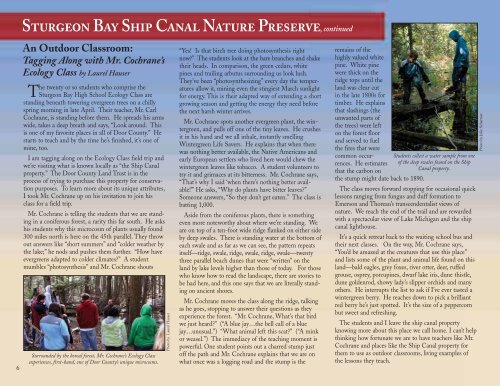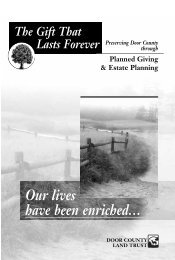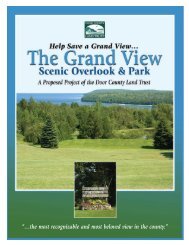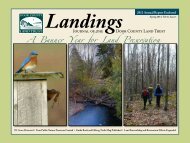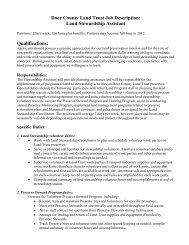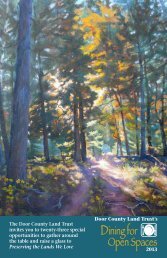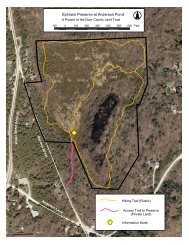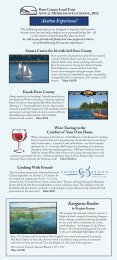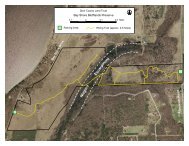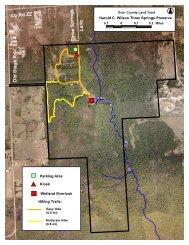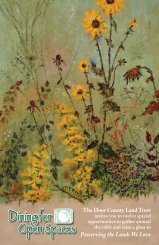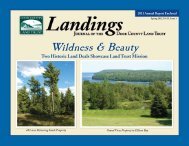Landings- Spring 2010 - Door County Land Trust
Landings- Spring 2010 - Door County Land Trust
Landings- Spring 2010 - Door County Land Trust
Create successful ePaper yourself
Turn your PDF publications into a flip-book with our unique Google optimized e-Paper software.
6<br />
Sturgeon Bay Ship Canal Nature Preserve, continued<br />
An Outdoor Classroom:<br />
Tagging Along with Mr. Cochrane’s<br />
Ecology Class by Laurel Hauser<br />
The twenty or so students who comprise the<br />
Sturgeon Bay High School Ecology Class are<br />
standing beneath towering evergreen trees on a chilly<br />
spring morning in late April. Their teacher, Mr. Carl<br />
Cochrane, is standing before them. He spreads his arms<br />
wide, takes a deep breath and says, “Look around. This<br />
is one of my favorite places in all of <strong>Door</strong> <strong>County</strong>.” He<br />
starts to teach and by the time he’s finished, it’s one of<br />
mine, too.<br />
I am tagging along on the Ecology Class field trip and<br />
we’re visiting what is known locally as “the Ship Canal<br />
property.” The <strong>Door</strong> <strong>County</strong> <strong>Land</strong> <strong>Trust</strong> is in the<br />
process of trying to purchase this property for conservation<br />
purposes. To learn more about its unique attributes,<br />
I took Mr. Cochrane up on his invitation to join his<br />
class for a field trip.<br />
Mr. Cochrane is telling the students that we are standing<br />
in a coniferous forest, a rarity this far south. He asks<br />
his students why this microcosm of plants usually found<br />
300 miles north is here on the 45th parallel. They throw<br />
out answers like “short summers” and “colder weather by<br />
the lake;” he nods and pushes them further. “How have<br />
evergreens adapted to colder climates” A student<br />
mumbles “photosynthesis” and Mr. Cochrane shouts<br />
Surrounded by the boreal forest, Mr. Cochrane’s Ecology Class<br />
experiences, first-hand, one of <strong>Door</strong> <strong>County</strong>’s unique microcosms.<br />
Photo by Laurel Hauser<br />
“Yes! Is that birch tree doing photosynthesis right<br />
now” The students look at the bare branches and shake<br />
their heads. In comparison, the green cedars, white<br />
pines and trailing arbutus surrounding us look lush.<br />
They’ve been “photosynthesizing” every day the temperatures<br />
allow it, mining even the stingiest March sunlight<br />
for energy. This is their adapted way of extending a short<br />
growing season and getting the energy they need before<br />
the next harsh winter arrives.<br />
Mr. Cochrane spots another evergreen plant, the wintergreen,<br />
and pulls off one of the tiny leaves. He crushes<br />
it in his hand and we all inhale, instantly smelling<br />
Wintergreen Life Savers. He explains that when there<br />
was nothing better available, the Native Americans and<br />
early European settlers who lived here would chew the<br />
wintergreen leaves like tobacco. A student volunteers to<br />
try it and grimaces at its bitterness. Mr. Cochrane says,<br />
“That’s why I said ‘when there’s nothing better available!’”<br />
He asks, “Why do plants have bitter leaves”<br />
Someone answers, “So they don’t get eaten.” The class is<br />
batting 1,000.<br />
Aside from the coniferous plants, there is something<br />
even more noteworthy about where we’re standing. We<br />
are on top of a ten-foot wide ridge flanked on either side<br />
by deep swales. There is standing water at the bottom of<br />
each swale and as far as we can see, the pattern repeats<br />
itself—ridge, swale, ridge, swale, ridge, swale—twenty<br />
three parallel beach dunes that were “written” on the<br />
land by lake levels higher than those of today. For those<br />
who know how to read the landscape, there are stories to<br />
be had here, and this one says that we are literally standing<br />
on ancient shores.<br />
Mr. Cochrane moves the class along the ridge, talking<br />
as he goes, stopping to answer their questions as they<br />
experience the forest. “Mr. Cochrane, What’s that bird<br />
we just heard” (“A blue jay…the bell call of a blue<br />
jay…unusual.”) “What animal left this scat” (“A mink<br />
or weasel.”) The immediacy of the teaching moment is<br />
powerful. One student points out a charred stump just<br />
off the path and Mr. Cochrane explains that we are on<br />
what once was a logging road and the stump is the<br />
remains of the<br />
highly valued white<br />
pine. White pine<br />
were thick on the<br />
ridge tops until the<br />
land was clear cut<br />
in the late 1800s for<br />
timber. He explains<br />
that slashings (the<br />
unwanted parts of<br />
the trees) were left<br />
on the forest floor<br />
and served to fuel<br />
the fires that were<br />
common occurrences.<br />
He estimates of the deep swales found on the Ship<br />
Students collect a water sample from one<br />
that the carbon on<br />
Canal property.<br />
the stump might date back to 1890.<br />
The class moves forward stopping for occasional quick<br />
lessons ranging from fungus and duff formation to<br />
Emerson and Thoreau’s transcendentalist views of<br />
nature. We reach the end of the trail and are rewarded<br />
with a spectacular view of Lake Michigan and the ship<br />
canal lighthouse.<br />
It’s a quick retreat back to the waiting school bus and<br />
their next classes. On the way, Mr. Cochrane says,<br />
“You’d be amazed at the creatures that use this place”<br />
and lists some of the plant and animal life found on this<br />
land—bald eagles, grey foxes, river otter, deer, ruffed<br />
grouse, osprey, porcupines, dwarf lake iris, dune thistle,<br />
dune goldenrod, showy lady’s slipper orchids and many<br />
others. He interrupts the list to ask if I’ve ever tasted a<br />
wintergreen berry. He reaches down to pick a brilliant<br />
red berry he’s just spotted. It’s the size of a peppercorn<br />
but sweet and refreshing.<br />
The students and I leave the ship canal property<br />
knowing more about this place we call home. I can’t help<br />
thinking how fortunate we are to have teachers like Mr.<br />
Cochrane and places like the Ship Canal property for<br />
them to use as outdoor classrooms, living examples of<br />
the lessons they teach.<br />
Photo by Julie Schartner


